Auctions
Q & A with Chinese Contemporary Artist Li Shan
Artist Li Shan, on political Pop art and the cultural role of the artist in China.
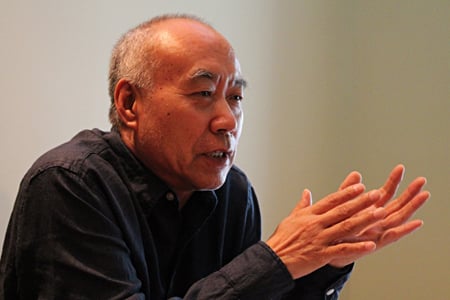
Artist Li Shan, on political Pop art and the cultural role of the artist in China.

Heather Russell

Heather Russell, senior specialist of Contemporary and Modern Asian Art, interviews Political Pop artist Li Shan, a leading figure in the Chinese avant-garde movement. Li is best-known for his provocative portraits of Mao Zedong, and his work has been featured in art exhibitions worldwide, including at the 1993 Venice Biennale, the Brooklyn Museum in New York, and the Museum of Contemporary Art in Shanghai.

Artist Li Shan, Photo by Soojin Seelye
Heather Russell: I know that you went to secondary school and university in Shanghai during the era of Mao Zedong and the Red Guards, before, during, and after the Cultural Revolution. Did this affect your work as an artist? If so, how?
Li Shan: I dropped out of Heilongjiang University in 1963, and was admitted to Shanghai Theater Academy to study Fine Arts in 1964. During that time most major art schools had stopped enrolling students, and Shanghai Theater Academy was the only one that was still open for enrollment. It was my first formal Fine Arts training.
In 1966, the Cultural Revolution broke out. Classes were suspended and all of my peers joined the Red Guards. No matter what you thought about the Revolution, you had to participate, otherwise you risked becoming the target of criticism. At that time, I already had a strong interest in art, and becoming an artist was my dream. That was also the reason why I chose to study at the Shanghai Theater Academy. But during the Cultural Revolution, the intellectuals and artists were the first to be attacked. Many intellectuals such as Wu Han (Chinese, 1909–1969), Deng Tuo (Chinese, 1912–1966), and Liao Mosha (Chinese, 1907–1991) were severely criticized and imprisoned. It was under these difficult circumstances that I realized the risk of pursuing a career in art. Historically, the artistic and cultural communities are always among the first to be affected during major political upheavals.
I was very young at the time, and I had thought about changing my career. During the Cultural Revolution, students from major art academies, including Shanghai Theater Academy, the Central Academy of Drama, Zhejiang Academy of Fine Arts, the Central Academy of Fine Arts, and the Central Conservatory of Music were not safe places to work post-graduation, because many of them were considered to be 516 Members, or the “black sheep” of society. I graduated in 1968 and remained unemployed until 1972. One of my high school classmates studied in the Harbin Institute of Technology, and he graduated the same year I did. He arranged for me to get job at the Chongqing Arsenal right after graduation. I remember writing him a letter asking if he could he find me a job in the Arsenal, hopefully designing propaganda paraphernalia, because I was an art student. Even though it ultimately didn’t work out, the experience of working there greatly influenced me.
During the Revolution, artistic practice was standardized throughout the country. Individuals were not allowed access to certain forms of artistic expression, so I had to suppress my own creative impulses for a long time.
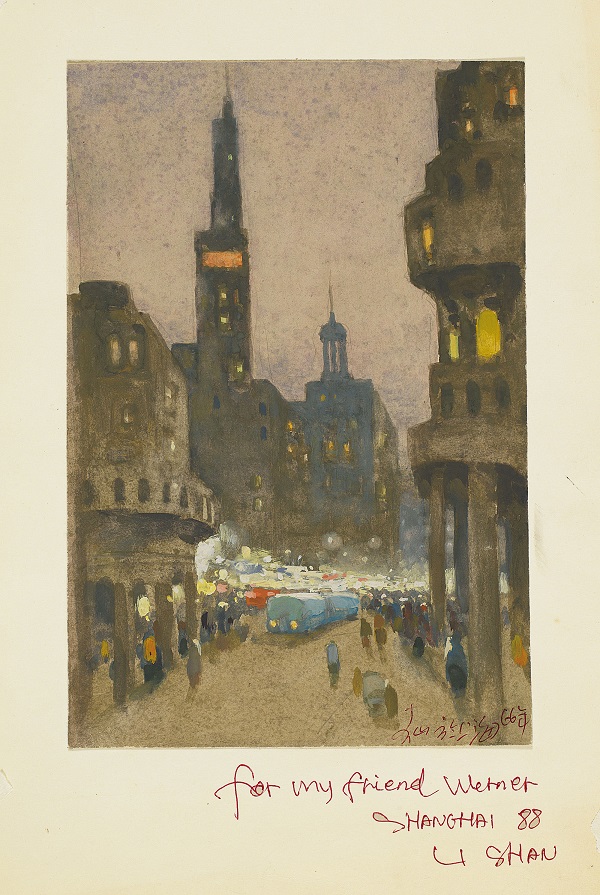
Li Shan, Shanghai Street View, 1966, sold at Shanghai Hosane Co., Ltd. for 28,750 RMB on July 7, 2013
HR: I know that from an early age, certain intellectual texts, such as books on quantum physics and Western writing, which were prohibited during the Cultural Revolution, have been very important to you as an individual and as an artist. What books, authors, and theories do you think have affected your work the most? And why?
LS: I have had different spiritual mentors at different stages in my life. When I was in junior high school, I had read some Fine Arts books that mentioned Leonardo da Vinci (Italian, 1452–1519). His masterpieces had all deeply impressed me, especially The Last Supper and the Mona Lisa. He was not only a master painter, but also an accomplished scientist, architect, and anatomist. I admire him a lot.
During my college years, I was introduced to various books about different art schools and movements. I especially came to appreciate the works of Henri Rousseau (French, 1875–1933), the Primitivist artist, and his life story. Rousseau’s works are extremely pure, real, and primal. I believe that paying attention to primal instincts is very important for artists.
The artwork that we see is often an artificial construct that has been carefully refined by the artist.
In addition, I had also read Stephen Hawking’s A Brief History of Time, and a few other books about quantum mechanics. In 1993, for my experiments in BioArt, I started to read Gregor Johann Mendel’s works. He was a Catholic priest, but he was also the founder of genetics. Although many of the books I’ve mentioned are scientific texts, I believe that the ability to challenge traditional thinking, like Stephen Hawking and Werner Heisenberg did, and the courage to explore the unknown, like Gregor Mendel, are both key characteristics of all great art.
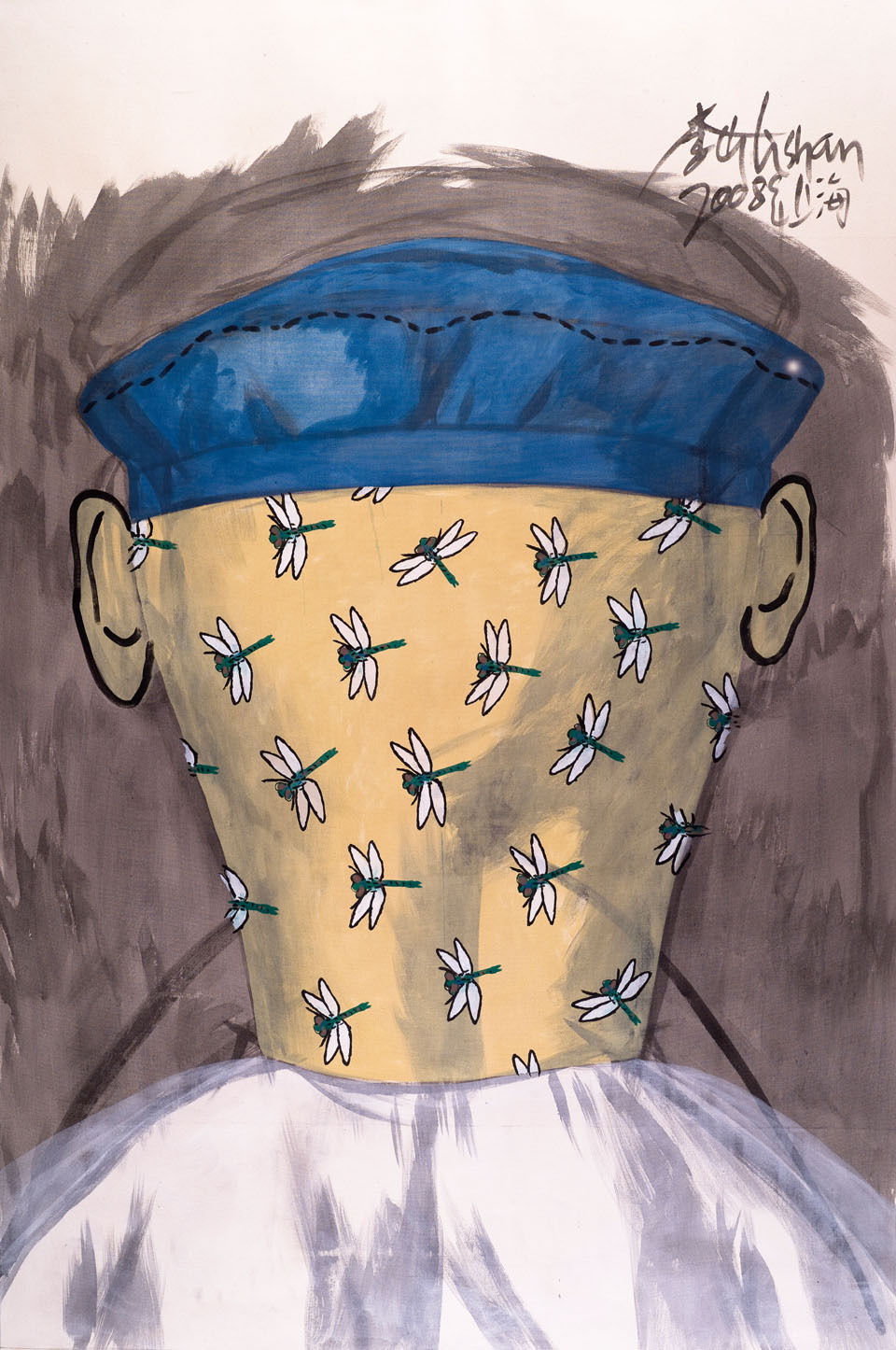
Li Shan, Reading, 2008, sold at Shanghai Hosane Co., Ltd. for 5,824,000 RMB on June 27, 2008
HR: You are known as one of the most influential and famous Contemporary Shanghai artists. Do you feel that living and painting in Shanghai, versus Beijing, has impacted your work and philosophy as an artist?
LS: There are many differences between Shanghai and Beijing, including politics, economy, history, culture, etc.
Politically speaking, the biggest difference between Shanghai and Beijing is that because Shanghai was once a colony, Western influence has had a profound cultural impact on things like lifestyle and interpersonal relationships. But in Beijing, traditional Chinese culture is much more prevalent. Comparisons have often been made between the two cities: Shanghai is typically seen as representing the bourgeoisie, while Beijing is thought of as the proletariat. But Shanghai is also viewed with a lot of mixed feelings.
Economically speaking, before the Chinese economic reform in the 1970s, xenophobia was very much a part of the Chinese mentality. Shanghai used to be a dream for many people. They wanted to go there to drink coffee and shop for clothing and shoes. After the economic reform, many major cities in China developed rapidly, and people became wealthier and wealthier. The xenophobic mentality that had persisted for so long gradually died down, as did the admiration for Shanghai.
In terms of culture and history, Shanghai is the gathering place for an older generation of artists, including writers, painters, musicians, etc. The majority of the first generation of artists who studied abroad came back to Shanghai, even if they left from other cities, they chose to move here after they returned to China. After the Chinese Civil War, there was a nation-wide turn towards the Soviet Union as a source of cultural influence. Artists began using the Chistyakov system, and drama students followed Stanislavski. But Shanghai was different. Shanghai attracted many Modern Chinese master painters such as Liu Haisu (Chinese, 1896–1994), Lin Fengmian (Chinese, 1900–1991), Wu Dayu (Chinese, 1903–1988), Guan Liang (Chinese, 1900–1986), and their students. At that time, the artworks being shown in exhibitions everywhere else mostly featured themes of workers, peasants, soldiers, and revolutionary heroes. Shanghai was the only place where you could still see paintings of osprey, reeds, and hydrangeas. It was also the only place where the Chinese tradition of Modern Art wasn’t interrupted. These masters and their students formed an underground community in Shanghai. I felt very lucky to have been able to live in such an atmosphere, and be exposed to what we called ‘Modernism’ when I came to Shanghai in 1964.
During the Cultural Revolution, the library of the Shanghai Theatre Academy was known for its rich collection of books. Professor Min Xiwen (Chinese, b.1918), who oversaw the library, was the area’s leading authority on Impressionist Art. Nearly all of the Chinese translations of Western texts on Impressionism were done by him. And he himself was a master of still-life painting. Thanks to Professor Min, I was exposed to Western classics through the books that he had secretly lent to me in the reading room. I would not have had that kind of opportunity if it wasn’t for the general cultural environment in Shanghai at that time. If I had gone to Beijing instead of Shanghai, the Li Shan (Chinese, b.1942) you see today would have been completely different.
As for the difference between the artistic communities in the two cities, artists in Beijing like to live close to each other, and their works tend to look similar. If one artist’s works were shown in an exhibition and gained a buyer’s market, other artists would begin emulating that particular style. But the artists in Shanghai are very scattered and individualized. Shanghai artists focus on developing their own styles, and they express their personal dreams and ideals in their work. As a result, Beijing artists pay closer attention to the choice of subject matter in art creation, whereas Shanghai artists focus more on the exploration of different artistic languages. That’s why it’s harder to curate an exhibition in Shanghai than it is in Beijing and Chengdu. Critics and curators often feel frustrated when they come to Shanghai, because it’s too difficult to find different artists creating works around the same theme. They can’t find what they are looking for.

Li Shan, Reading (set of 10), 2002, sold at Shanghai Hosane Co., Ltd. for 23,520,000 RMB on June 24, 2009
HR: Your work is often referred to as Political Pop Art. Do you accept or reject this label? Do you associate your art with a specific movement?
LS: The term Chinese Political Pop was initially proposed by Li Xianting during the late 1970s in order to better sort and classify Chinese Contemporary Art, and to facilitate artistic discussion. It was chosen mostly because there was no alternative. There was a long debate about the term, and it was decided that Political Pop Art would be used temporarily; little did we know that it would be written into history.
On the surface, Chinese Political Pop Art is similar to Western Pop Art. They have the same artistic language, and both appeal to the general public. Much like the works of Andy Warhol (American, 1928–1987), they are very straightforward, and directly comment on the present commercial and political environments.
However, comparatively speaking, Chinese Political Pop Art has a deeper meaning. The movement is about artists expressing their thoughts on Chinese history, culture, and the social environment, as well as their feelings toward their personal experiences. So each artist and each work is distinct.
I have no complaints about being labeled as a Political Pop artist, but I think having a conversation directly with the artist is necessary if one wishes to acquire a deeper understanding of the work.
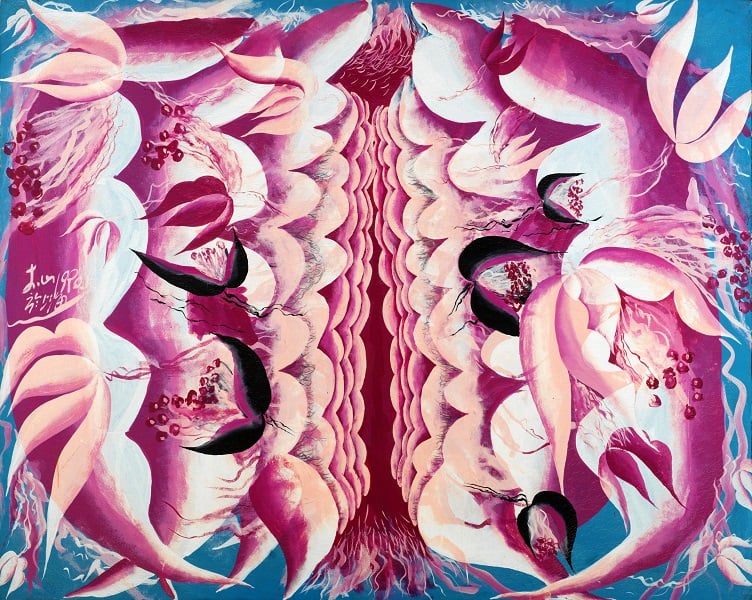
Li Shan, Rouge No. 9, 1990, sold at Shanghai Hosane Co., Ltd. for 2,070,000 RMB on July 7, 2013
HR: Your most internationally acclaimed series of paintings belongs to your decades-long Rouge series that features a young, effeminate Mao Zedong with a lotus flower in his mouth, as well as other political leaders, such as United States President Ronald Regan. Can you explain how you were inspired to create this series and what the message is behind these works? What does the title mean? Why did you focus on a younger Mao, and only create a handful of paintings of an elderly Mao?
LS: Concepts like “effeminate” and “unisex” are unique in China because defining them falls into a cultural gray zone. Regardless of time or place, there are always particular cultural ideas that can’t be easily explained in black and white terms. It feels contradictory because we are so used to defining things in extremes: left versus right, good versus bad, right versus wrong, etc. However, this gray zone is a constant state of affairs in Chinese society.
For artists, this gray area creates a very interesting environment. This uncertain state is usually linked to phrases like melancholy and ambiguity. I used the image of Mao Zedong in my paintings as a cultural symbol. People have an ingrained impression of older Mao, one that’s powerful and authoritarian. However, middle-aged and younger Mao is not attached to the same kind of preconceived historical, cultural, and social signals. I feel that the image of middle-aged Mao always has a trace of melancholy and ambiguity, while younger Mao is ambitious and vibrant, which leaves a clear image in peoples’ minds. It returns Mao to the primitive state I mentioned previously. This unfamiliar image can lead audiences to rediscover that grey area, separate them from the extremist historical period that they are familiar with, and change the “cultural genes” of that age.
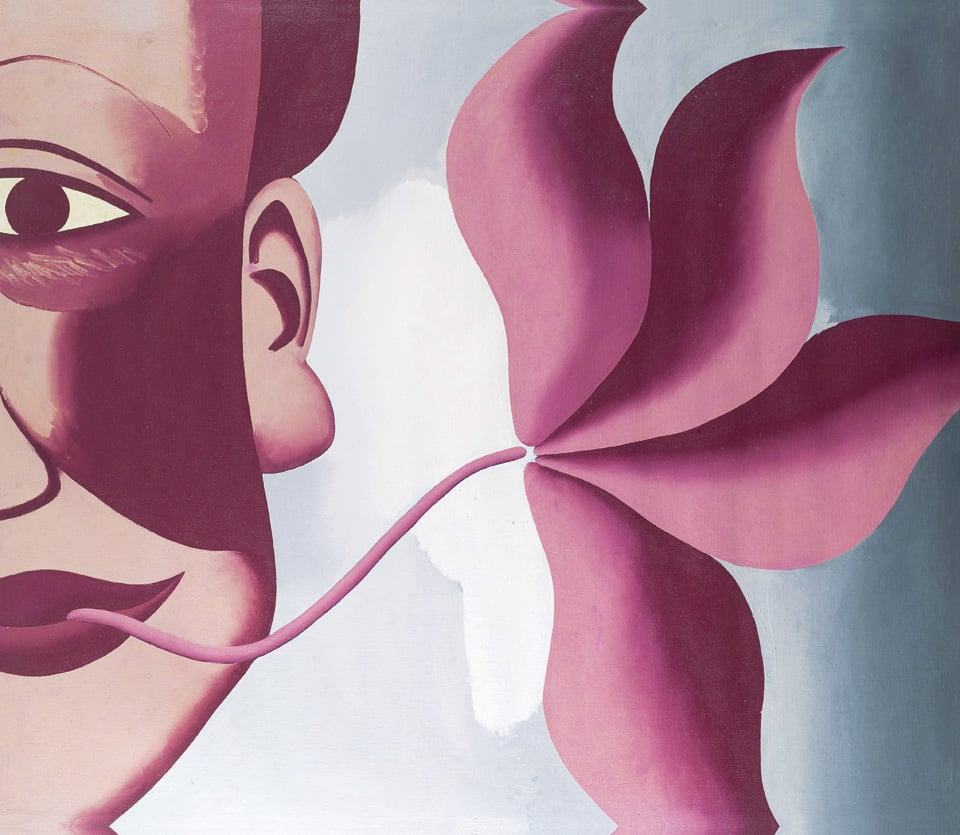
Li Shan, Rouge, 1989–1998, sold at Shanghai Hosane Co., Ltd. for 3,105,000 RMB on June 27, 2010
HR: You often create Mao Zedong portraits with images of geese or psychedelic versions of the lotus flower in your Rouge series. Can you explain what the geese and lotus represent?
LS: Geese are lazy, and the lotus flower is tacky. I feel that both of these symbols match the theme of “rogue” perfectly.
HR: You have worked on several highly acclaimed works in your Reading series, including large-scale paintings of animals typically covered in fish, dragonflies, or butterflies, painted in an almost naíve manner. What can you tell us about the inspiration and meaning of this series?
LS: On Wikipedia, these pieces are categorized as BioArt. These works apparently have a certain connection to advancements in biology. In the 1950s, scientists discovered the fundamental element of the life, the gene. At the same time, they discovered the mechanism of heredity. When a human being masters the technology that could potentially enable us to create new lives, this poses a huge challenge to traditional ideology, religion, and cultural history. These kinds of events are too significant for anyone, including artists such as myself, to ignore. It’s natural that artists would start associating this event with their artistic creations, and that BioArt would become a new category within the field of Contemporary Art.
I started to think about BioArt when I came back from the Venice Biennale in 1993. From 1994 to 1996, I had the opportunity to stay in New York to start preparing for my own BioArt projects. I read books in related fields, including college textbooks. My basic concept for BioArt is that it must be living. Some of my paintings that you’ve seen are actually proposals and drafts of a new species that I want to create in a lab. I spent two or three years on the preparation, until early 1998, when I wrote my first essay about BioArt and completed a proposal on how to create a living artwork. I named this proposal Reading. But, as you can imagine, it was very difficult to find a scientist in China who wanted to work with an artist to create a new species. It was not until 2007 that I found an expert at the Shanghai Agricultural Science Academy to collaborate with me in cultivating a batch of pumpkins. That was my first living BioArt piece. I found that project to be very meaningful because I was able to present the basic concept of BioArt, the process of making BioArt, and the form of BioArt through the project. Reading is also the first BioArt proposal in history.
At this point, people might not be familiar with BioArt yet, in which case, they can use Reading as an example. The defining characteristic of BioArt is that the work must be living, it should experience the entire process of conceiving, being born, growing up, aging, and passing away. It should also be able to reproduce. Therefore, it’s completely different from the art that we’re used to. BioArt work has to be created through genetic alteration, designed by artists, and executed by scientists. In the current state, it’s very hard for artists to complete a BioArt work by him or herself.
At the end of last year, I had a solo exhibition at the Museum of Contemporary Art in Taipei, Taiwan. One of the works exhibited was called The Possibility of Random Expression. This is a project that I did in collaboration with a professor at Tsinghua University. The project took a year to complete, but it was very unsatisfying. What I most wanted to learn about in the lab was the process of genetic alteration. But for safety purposes, I wasn’t given access to that information. In the end, I was only able to see the 72-hour growing process of the embryo after genetic alteration. This experience made me realize the difficulty in working with scientists. It would be wonderful if I could have my own lab.
I travelled to Beijing three times for this project, to communicate with the scientist I was working with. And during the discussion, I raised a new concept. Based on my understanding of molecular biology, gene expression is divided into two main parts, Transcription (DNA to RNA) and Translation (RNA to protein). Both of these processes are regulated by a control system, which determines the appearance of each life created. I wondered, if we could disable this control system, and let genes express randomly, what would the end result look like? It could be something unimaginable, but in theory, this is the only way a life could gain freedom. Would you be willing to see a life that’s created through this random gene expression? It could be a monster, but it’s a life that’s completely free.
HR: Yes, absolutely! I think it’s very exciting. A monster can be beautiful. Who is to define what a monster is?
So I guess our final question is, what is your next step, where do you go from here, and where is your next gallery exhibition or museum show?
LS: Early next year, I will have an exhibition in Singapore. This exhibition will show my early Extension series. Many important works in this series had been destroyed many years ago, so I wanted to take this opportunity to recreate these works. The curator of this exhibition will probably be Gao Minglu.
Although I have run into many obstacles in the process of creating BioArt, and none of my previous works, except for the Pumpkin project, was truly satisfying, I would still continue to create works, most likely in labs. I’m also going to continue with the painting and photography side of BioArt. These are all proposals for my future BioArt projects. But the sad news is that, according to one scientist, it would take 100 years to complete all of these projects.
This interview was originally conducted in Chinese, and was translated by Ning Lu, associate manager of the artnet Price Database Fine Art and Design and Chunmei Jia, intern at artnet Price Database Fine Art and Design. Click here to read the Chinese version.